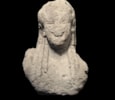Head Of A Kore Or Sphinx
That the torso represents a female rather than a male is implicit from the tunic (the neckline is faintly visible) and the character of the coiffure with its long tresses, three to each side of the face, falling loosely across the shoulder and down the front of the body. At the back of the head, the hair, which is neatly arranged in nine long parallel tresses with striations that create an overall herringbone pattern, terminates in a horizontal undulating edge near the shoulder blades. The hair is swept back in a bold wave over the ears, and thereby imparts a greater prominence to the ears. Given the incomplete nature of the sculpture once cannot altogether discount the possibility that it may represent a sphinx.
Greek, Roman, Egyptian and Near Eastern Antiquities, Sotheby’s, London, 5 March 1962, Lot 144.
‘Etruscan Art’, Otis Art Institute of Los Angeles County, 1963, pg. 12.
M. Del Chiaro, ‘Etruscan Art from West Coast Collections’, Santa Barbara, 1967, no. 13
‘The J. Paul Getty Museum Journal, Volume 5, 1977, pg. 49, object 2, images 7-9.
Sold at: Greek, Roman, Egyptian and Near Eastern Antiquities, Sotheby’s, London, 5 March 1962, Lot 144.
With Dr Elie Borowski (1913-2003), Basel, c.1970’s.
‘Baron’ Family Collection, received as a gift from the above in the 1970’s.
Thence by descent.
ALR: S00150860.










 Enquire
Enquire




